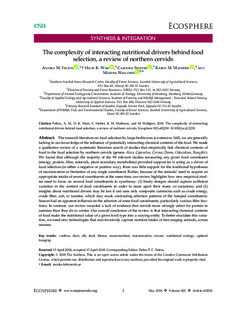The complexity of interacting nutritional drivers behind food selection, a review of northern cervids
Peer reviewed, Journal article
Published version
Date
2018Metadata
Show full item recordCollections
Abstract
The research literature on food selection by large herbivores is extensive. Still, we are generally lacking in our knowledge of the influence of potentially interacting chemical contents of the food. We made a qualitative review of a systematic literature search of studies that empirically link chemical contents of food to the food selection by northern cervids (genera Alces, Capreolus, Cervus, Dama, Odocoileus, Rangifer). We found that although the majority of the 98 relevant studies measuring any given food constituent (energy, protein, fiber, minerals, plant secondary metabolites) provided support for it acting as a driver of food selection (in either a negative or positive way), there was little support for the traditional hypotheses of maximization or limitation of any single constituent. Rather, because of the animals’ need to acquire an appropriate intake of several constituents at the same time, our review highlights how new empirical stud- ies need to focus on several food constituents in synchrony: (1) Study designs should capture sufficient variation in the content of food constituents in order to tease apart their many co-variations; and (2) insights about nutritional drivers may be lost if one uses only composite currencies such as crude energy, crude fiber, ash, or tannins, which may mask contrasting selection patterns of the lumped constituents. Season had an apparent influence on the selection of some food constituents, particularly various fiber frac- tions. In contrast, our review revealed a lack of evidence that cervids more strongly select for protein in summer than they do in winter. Our overall conclusion of the review is that interacting chemical contents of food make the nutritional value of a given food type into a varying entity. To better elucidate this varia- tion, we need new technologies that non-invasively capture nutrient intake of free-ranging animals, across seasons. The complexity of interacting nutritional drivers behind food selection, a review of northern cervids
